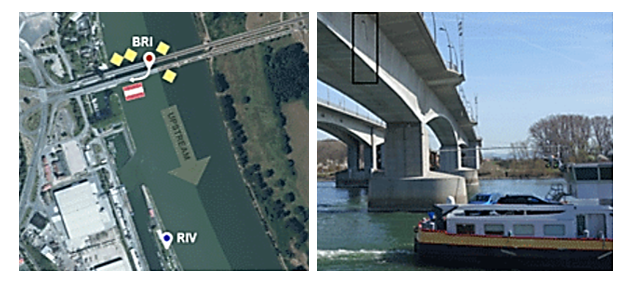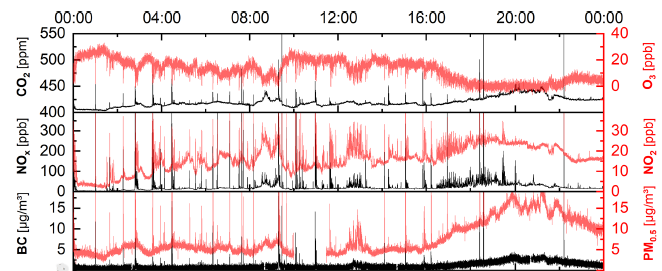It’s not just our staff who work as a team at 2B Tech. Sometimes our 2B Tech instruments do, too.
Three of our instruments spent over a year on the Rhine River, as part of an array of instruments aimed at looking at the emissions from ships traveling inland on the Rhine. The Model 205 and 405 nm measured ozone (O3), nitrogen dioxide (NO2), and nitric oxide (NO), and the Model 714 provided a calibration source for all three.
The Rhine is Europe’s busiest inland waterway for the shipping of goods. And it’s expected to get busier, by 50%, as Europe favors shipping as the most environmentally friendly way to move goods within the continent. That makes it especially timely that the most detailed study to date of ship emissions under real-world conditions has recently been published — in August 2023 by Eger et al. in Atmospheric Chemistry and Physics. In the study, instruments housed in a station on a bridge above the Rhine sniffed the plumes of the passing ships, and other instruments on a riverbank made measurements that were more representative of the pollution exposure of people onshore. About 4700 ship passages were analyzed for CO2, NO, NO2, particle number count, PM1, PM2.5, and black carbon during 14 months spanning March 2021 to June 2022.

Left: Rhine River air measurement stations on the bridge (BRI) and at the riverbank (RIV). The yellow diamonds indicate ship passage lanes. Right: The bridge measuring station, with the suspended sampling line shown in the black box. Modified from Figure 1 of Eger et al., Atmospheric Chemistry and Physics, 23, 8769-8788 (2023).
At the bridge location where the plumes were directly sampled closest to the source, shipping had the biggest influence on NOx levels (an increase of 50% within the plumes above background levels). Black carbon was higher by 15%, and particle number counts and PM1 had modest increments of 10% and 4% in the plume. Along the riverbank, NOx contributions were lower (8%), as would be expected from dilution at greater distances from the passing ships. Ultra-fine particles (<100 nm diameter) dominated the particulates observed, making up 75% of the distribution. The authors point out that studies that don’t measure this component of the particle distribution would be missing a key part of the emissions inventory.

One day’s measurements in December 2021 of ship plumes from the bridge station over the Rhine River. Ship plumes are detected as spikes in most species and a drop in ozone. Modified from Figure 3 of Eger et al., Atmospheric Chemistry and Physics, 23, 8769-8788 (2023).
One overall point confirmed by the study: The plumes from inland ships can’t be compared with seagoing ship plumes. Differences in motor dimensions, fuel sulfur content, driving conditions, and particle filtering technology lead to different emission profiles.
The ships in the study had a wide range of engine types and engine ages, and the authors took a detailed look at engine characteristics to see their relationship to the emissions. One bright spot: the more modern the engine, the cleaner the plume. Only a few ships they studied had the latest engine technology, but the finding bodes well for the future. The authors estimate that fully transitioning the commercial shipping fleet, which is bound to happen eventually, would reduce emissions by ~90% and greatly improve air quality for residents along inland rivers with heavy ship traffic.
——————————
Measurement Report: Inland ship emissions and their contribution to NOx and ultrafine particle concentrations at the Rhine, P. Eger, T. Mathes, A. Zavarsky, and L. Duester, Atmospheric Chemistry and Physics, 23, 8769-8788, 2023.

